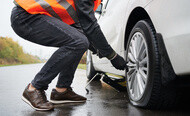
Tips & advice for car and suv tyres
Getting stuck with a flat tyre is an unfortunately common occurrence that all drivers experience at some point. That’s why it’s essential to know exactly what to do when you get caught out – and to make sure you have all the equipment necessary to make a quick flat tyre change, so that you can get back on the roads as soon as possible.
Changing a flat tyre with a spare tyre
Fortunately, changing a tyre isn’t too difficult if you know what to do. Here we show you the simple steps you need to follow to sort out that flat, as well as answering some of the most common questions about changing a flat tyre.
Before you drive anywhere, you should always make sure you have all the things you’ll need to change a spare tyre. Most of these should come with your vehicle, but others are useful extras to have stored in your glove box for a wide range of potential emergency situations, such as a flashlight or car puncture repair kit.

Essential equipment you’ll need to change a tyre:
- A jack
- A vehicle owner’s manual
- A fully inflated spare tyre (make sure to check the air pressure regularly!)
- A lug wrench
Helpful extras
- A flashlight
- Wheel wedges
- Car puncture repair kit
A step by step guide
Step 1: Pull off the road and find a safe spot
As soon as you realise you’ve punctured your car tyre, slow down your speed and avoid any abrupt movements. Look for a straight stretch of road with level ground, such as a parking lot, or if necessary, a hard shoulder with enough room for you to manoeuvre safely around the car.
Step 2: Park the car and turn on your hazard lights
Remember that you must only work on your vehicle in a safe, permitted location and that the vehicle must be on stable ground. Make sure other drivers are aware of your tyre change situation by turning on your hazard lights, particularly if you’re next to a busy road with lots of traffic. Do not forget to put on your high-visibility jacket and if you have a reflective warning sign, put that up a few feet behind your car too.
Step 3: Put wheel wedges in place
If you have wheel wedges, place these around the tyres opposite where the flat one is to stop the car from potentially rolling (e.g., if the flat tyre is at the back, put these at the front). The wheels should be chocked, the parking brake on, and in gear (or Park for an automatic), so that the vehicule cannot roll.
Step 4: Check you have all the equipment you need
Get your jack and lug wrench out of the car and check the vehicle manual for any essential information on your car model. Locate your tyre, which can usually be found in a compartment on the floor of the trunk, and check it is fully inflated. If there is a safe place for you to put the tyre, such as a grassy area next to the car, take it out and carefully place it there.
Step 5: Remove the hubcap or wheel cover from the damaged tyre
If your tyre has a hubcap or wheel cover that covers the lug nuts, remove this with the flat end of your wrench. Place this on the side.
Step 6: Loosen the lug nuts on the tyre
Use your lug wrench to loosen the lug nuts, which can be found just below the hub cap. These are normally round or hexagonal and can be loosened by applying pressure and pushing counter clockwise. Don’t remove them completely but loosen them around 1/2-1/4 of a turn to unlock them.
Step 7: Lift the car with the jack
Position the jack under the vehicle frame close to the flat tyre – you might find that your vehicle actually has a cleared area of exposed metal that’s specifically designed to place a jack. Check your owner’s manual for full details, and to avoid causing any damage.
Once in place, turn the jack handle in a clockwise fashion until the flat tyre is a few inches off the ground. Place the jack handle under the car to hold it there, and never put any part of your body under the vehicle while it is being supported by the jack.
Step 8: Remove the lug nuts
Continue unscrewing the lug nuts until you can remove them completely and set them aside in a safe place.
Step 9: Take off the tyre
Grip the tyre and pull it gently off the hub, then set it aside safely so it doesn’t roll away.
Step 10: Mount the spare tyre
Take your spare tyre and line it up with the lug bolts, then push it in gently until the end of the lug bolts shows through the rim. Place the lug nuts back on and tighten them all by hand before checking they’re all secure.
Step 11: Lower the car until its touching the ground
Bring the jack down so that the new tyre is touching the ground, but without the full weight of the vehicle on it. Tighten the lug nuts with the wrench as tightly as you can.
Step 12: Finish lowering the car
Bring your car down all the way and remove the jack, before checking the tightness of the lug nuts again.
Step 13: Replace the hubcap
If you’re able to use the hubcap from your flat tyre on your spare tyre, put it in place now. Otherwise, keep it and stow it away.
Step 14: Put everything away
Put the flat tyre in the space where the spare tyre is kept, and make sure you don’t forget any of your equipment while packing up.
Step 15: Final check
Remember that your spare wheel should be at the correct pressure to make sure it’s safe to drive on. If you have any immediate concerns, call your vehicle recovery agent. They may be able to replace the spare tyre for you and they should make sure that your car is safe to drive to the nearest garage for an assessment.
Frequently asked questions:
How long can you use a spare tyre for?
Depending on the type of spare tyre you have, they’re usually not designed to be used for a long time – or at particularly high speeds. Some car models only have space for smaller spare tyres, which shouldn’t be driven over 50 miles per hour as they have less traction and are less able to handle the road in poor weather. Keep in mind that your spare tyre could also be a different season tyre from the other ones on your car.
Once the spare is fitted, visit a tyre specialist as soon as possible to make sure that the wheel is secure and for an inspection of your damaged tyre. If the spare is a Temporary Use or Space Saver spare, you must comply with the restrictions on use as described in your vehicle handbook. But as a rule, check in with your garage as soon as you’re able to for a full assessment and to replace your flat tyre with a new one.
When should you change tyres?
It is strongly advised to change tyres after 10 years. However, if you notice that you tyre is damaged or has reached the legal tread wear limit before this period, it must be replaced.
As a rule of thumb, you should get your tyres checked by a professional every 5-6 years.
How long does it take to put a spare tyre on your car?
Depending on how confident you are, a punctured tyre can be changed for a spare tyre in less than 30 minutes, but make sure to take your time, and proceed safely through each step. Also, your spare tyre must be at the correct pressure, it is important to check the pressure of the spare tyre regularly at every safety check with a professional. If you have any doubt, it can be a good idea to practice changing a tire in a secure location, such as when parked at home.
Before you drive anywhere, you should always make sure you have all the necessary tools you’ll need to change a spare tyre just in case. Most of these should come with your vehicle, but others are useful extras to have stored in your glove box for a wide range of potential emergency situations, such as a flashlight or car puncture repair kit.

Find a tyre dealer near you in seconds
Search by
Address, City or ZIP code
Car
Locate me
Top 5 cities in Africa
Find the perfect tyre
Enter your vehicle or tyre size
We're searching for your tire...
Wait few seconds we're processing your photo

